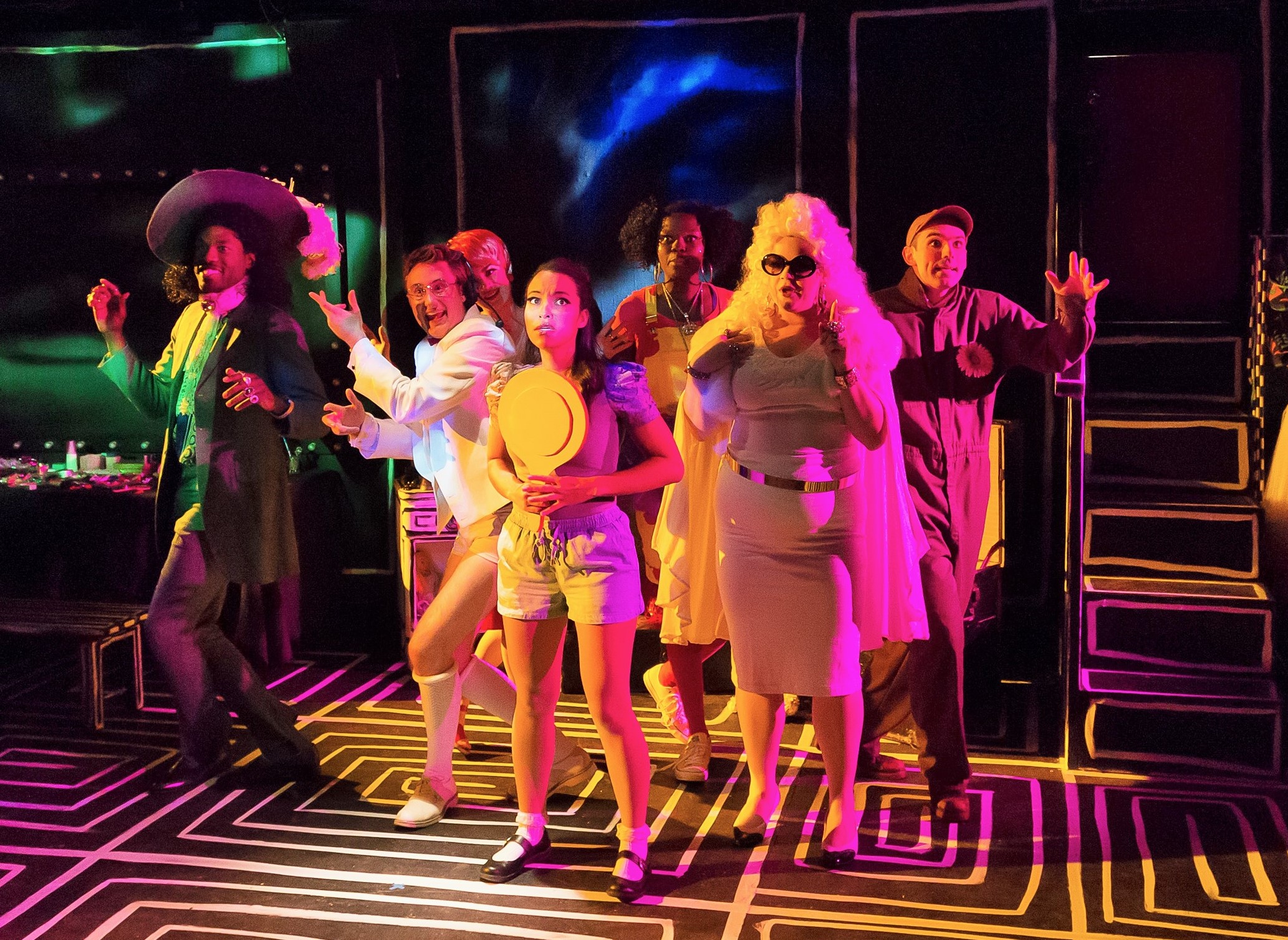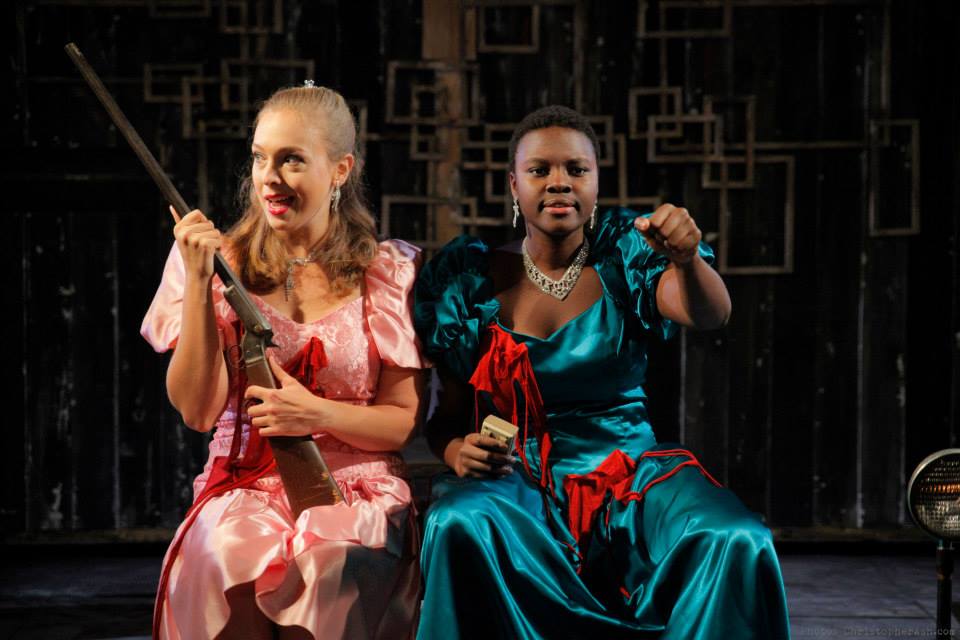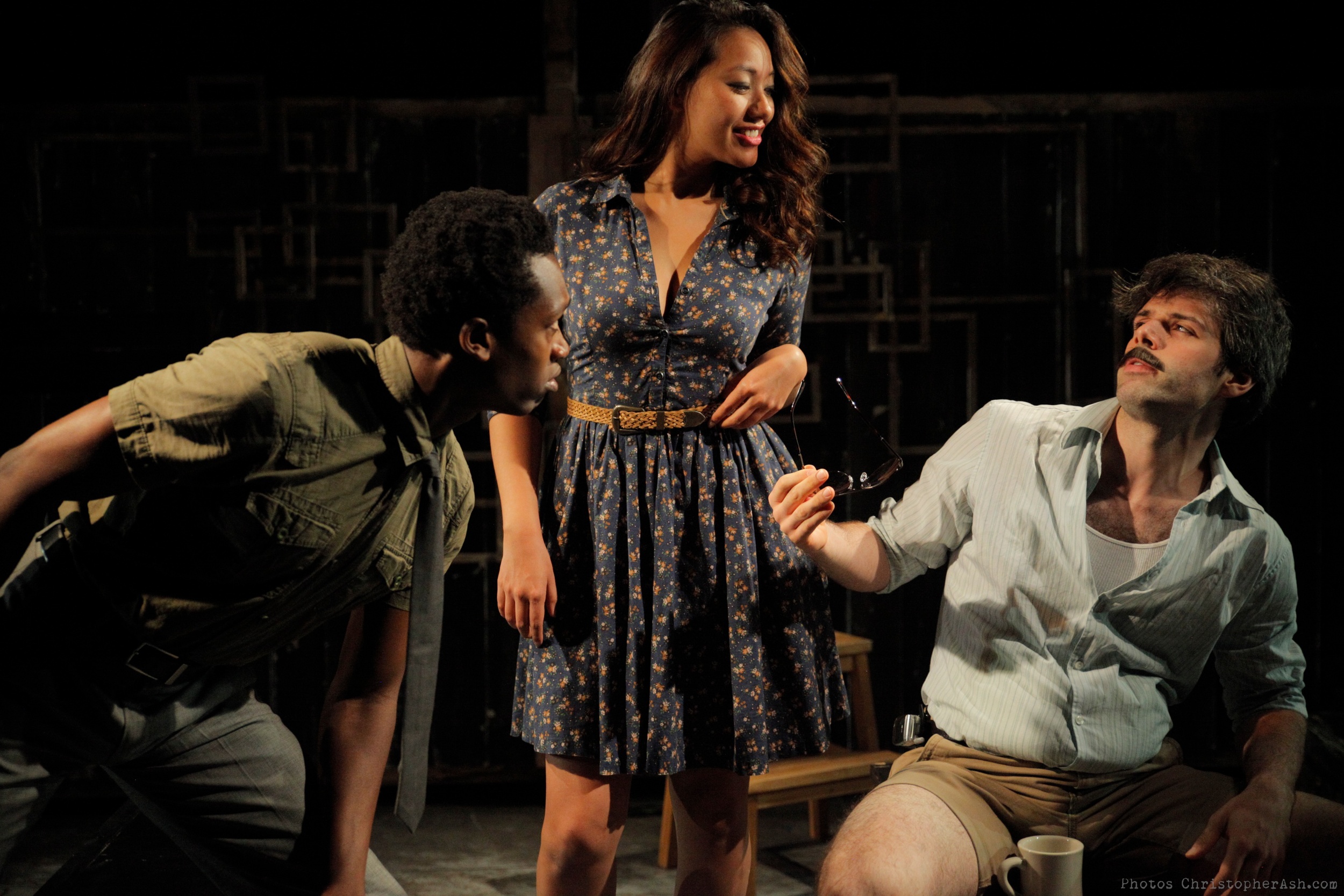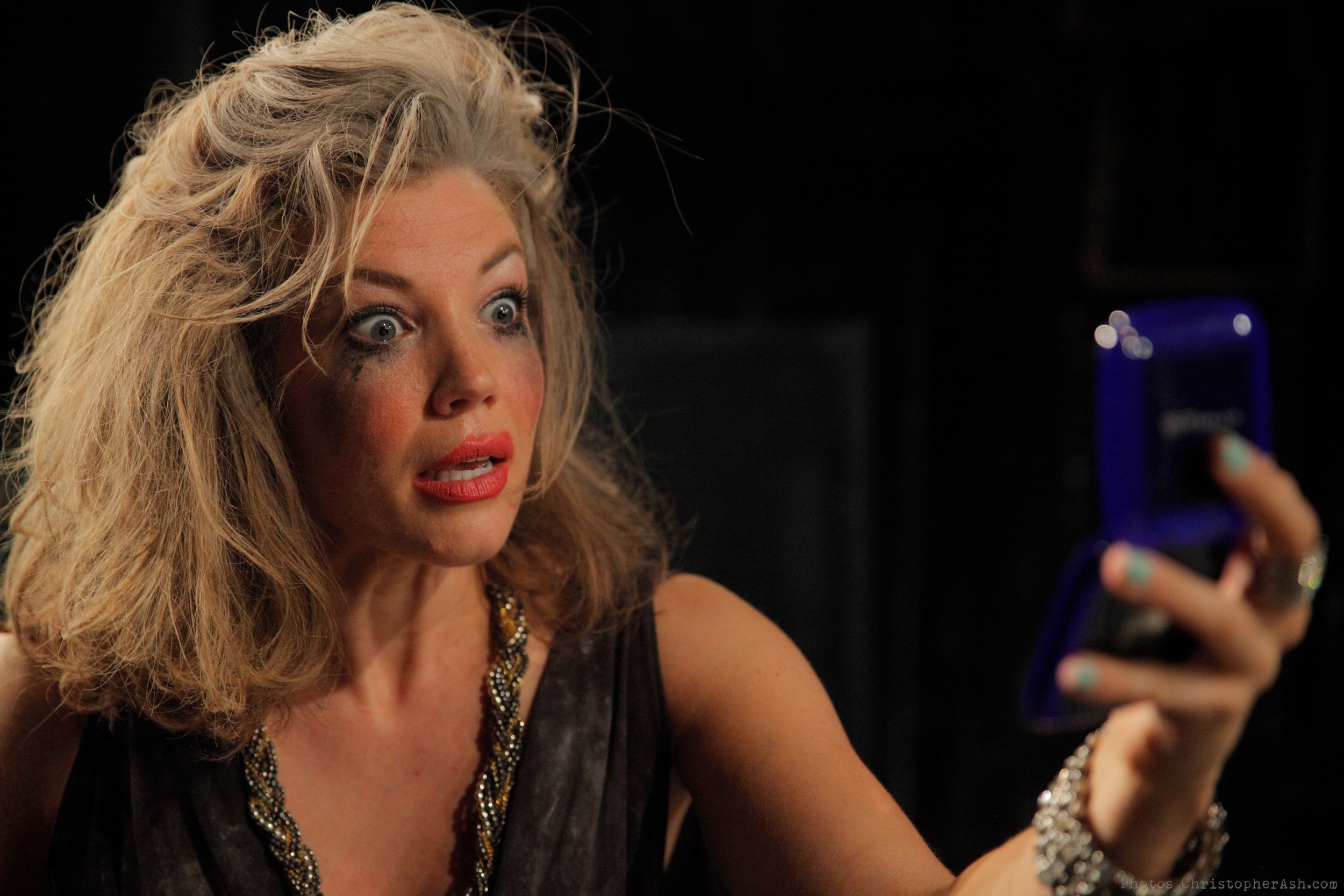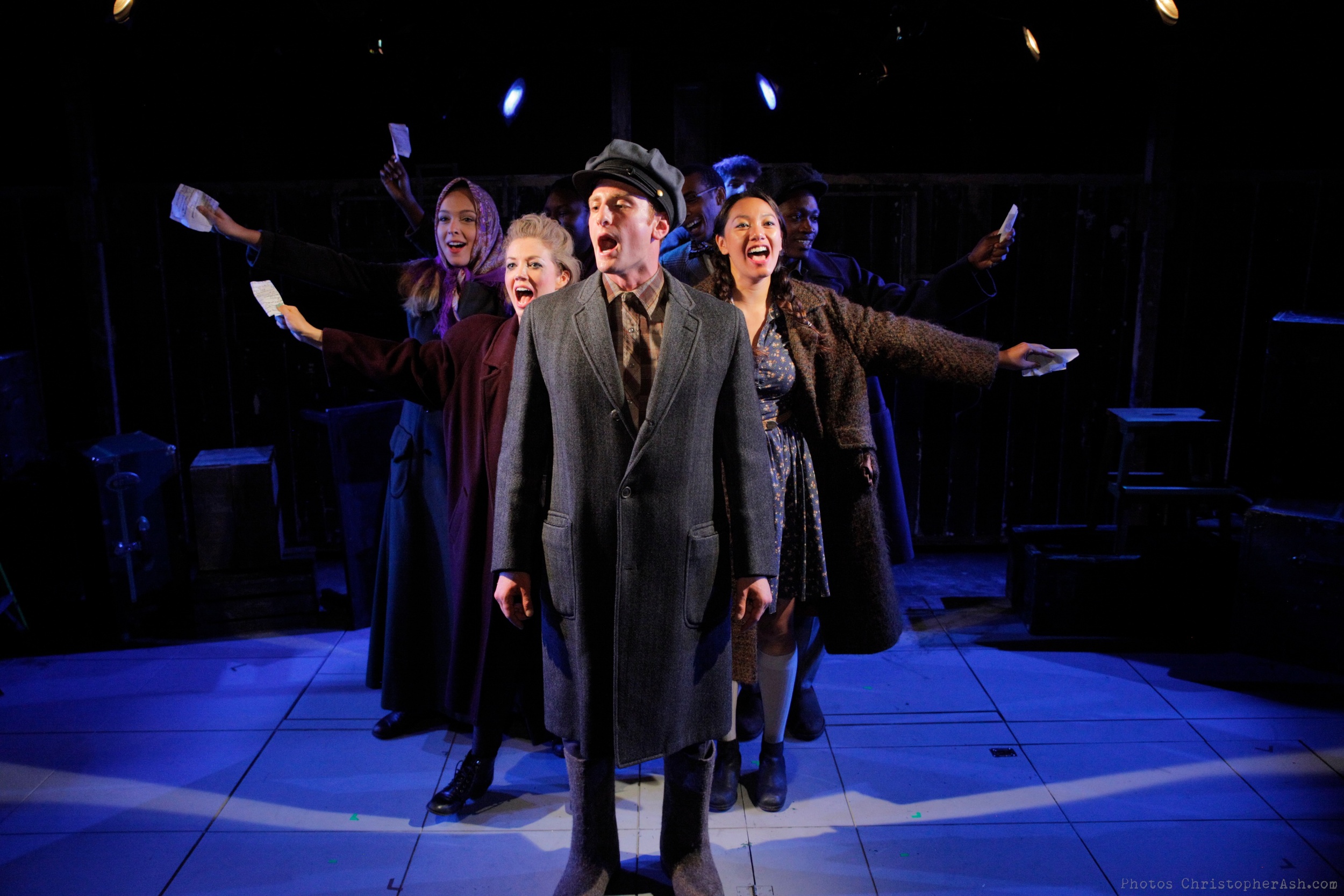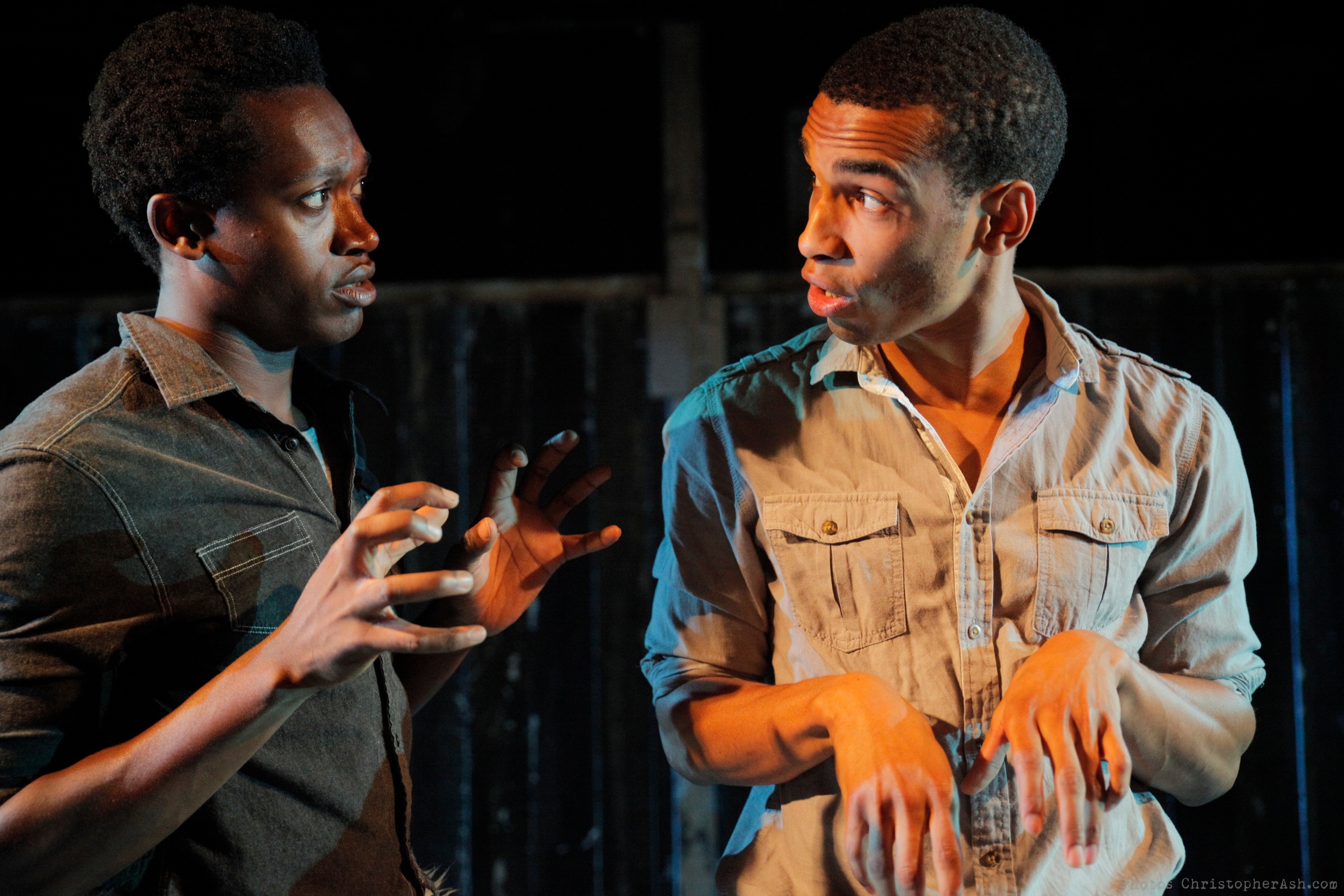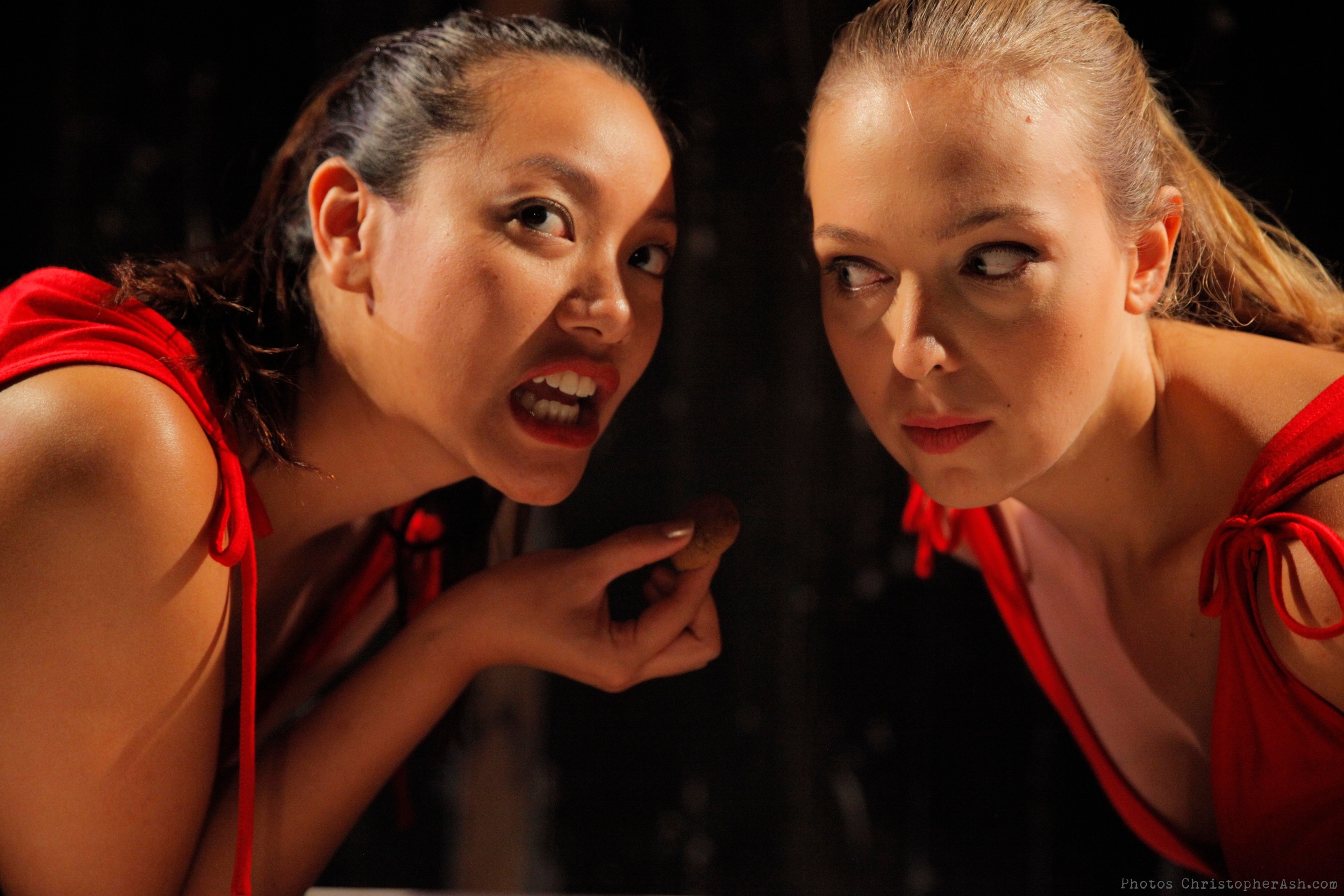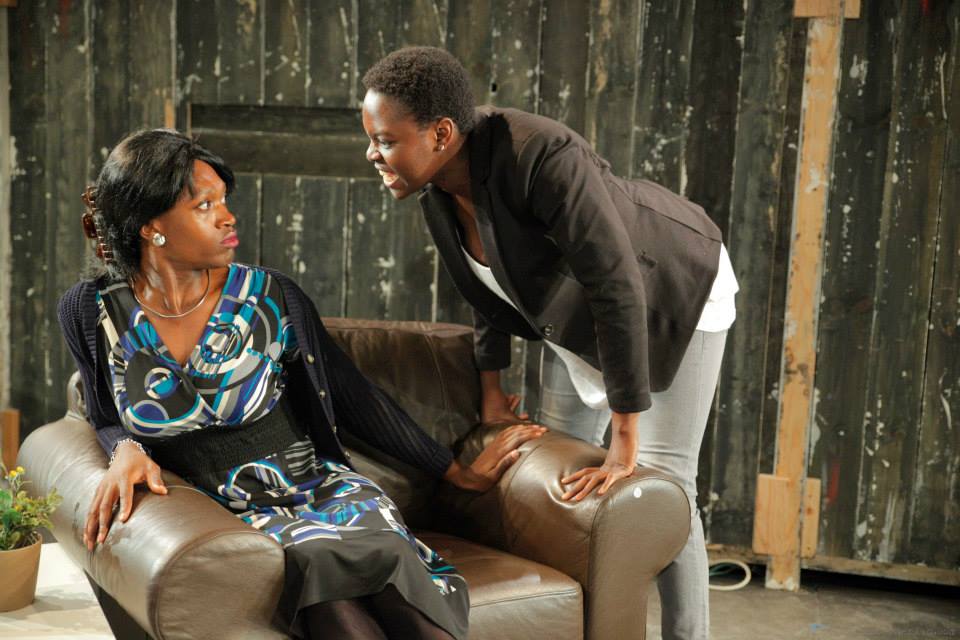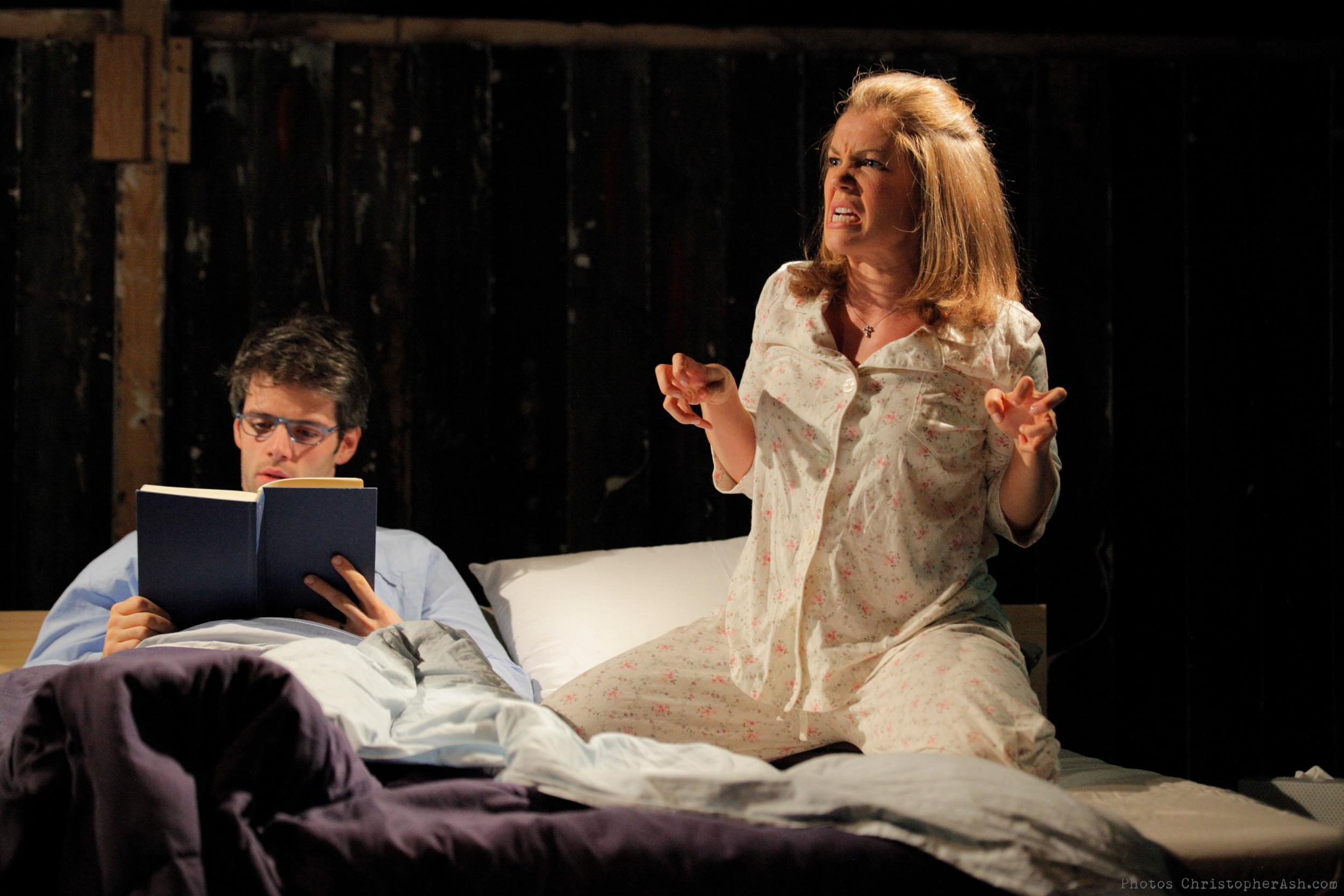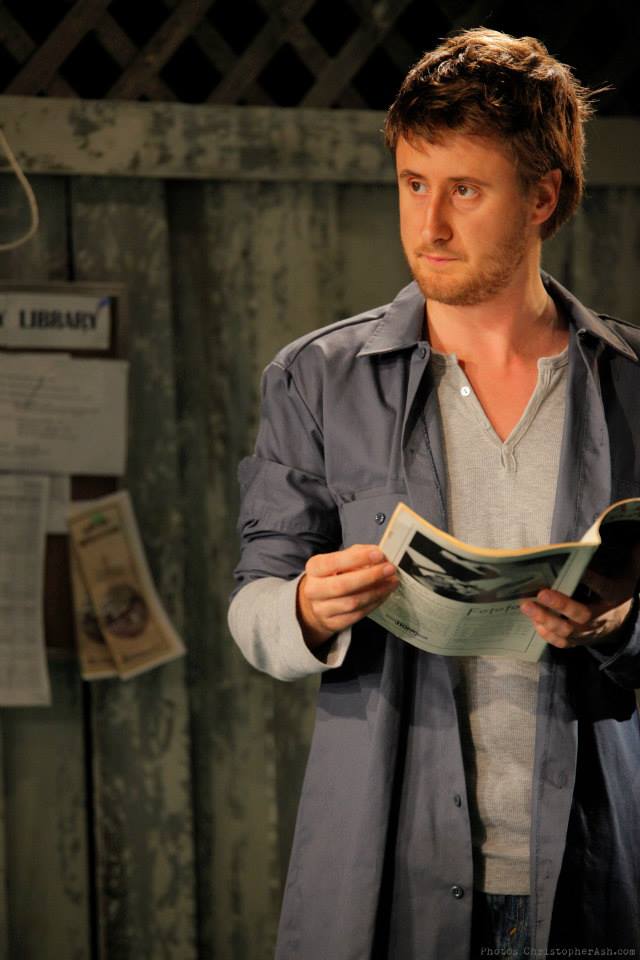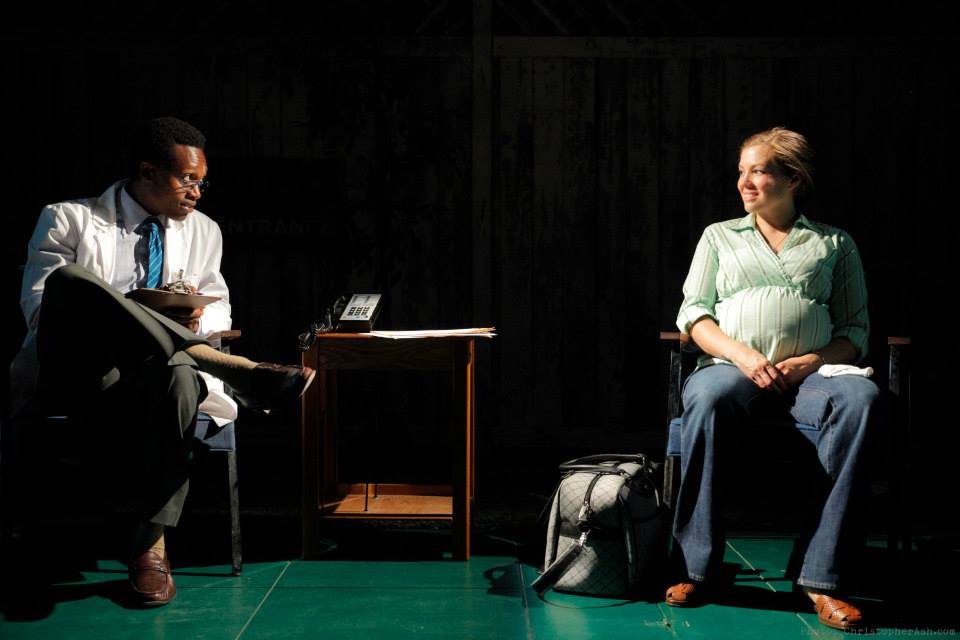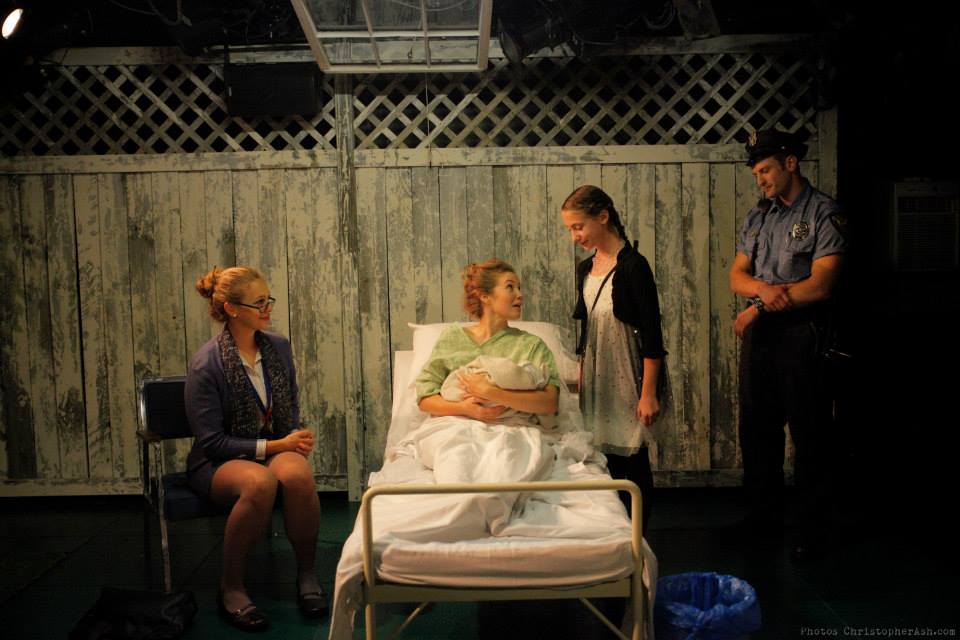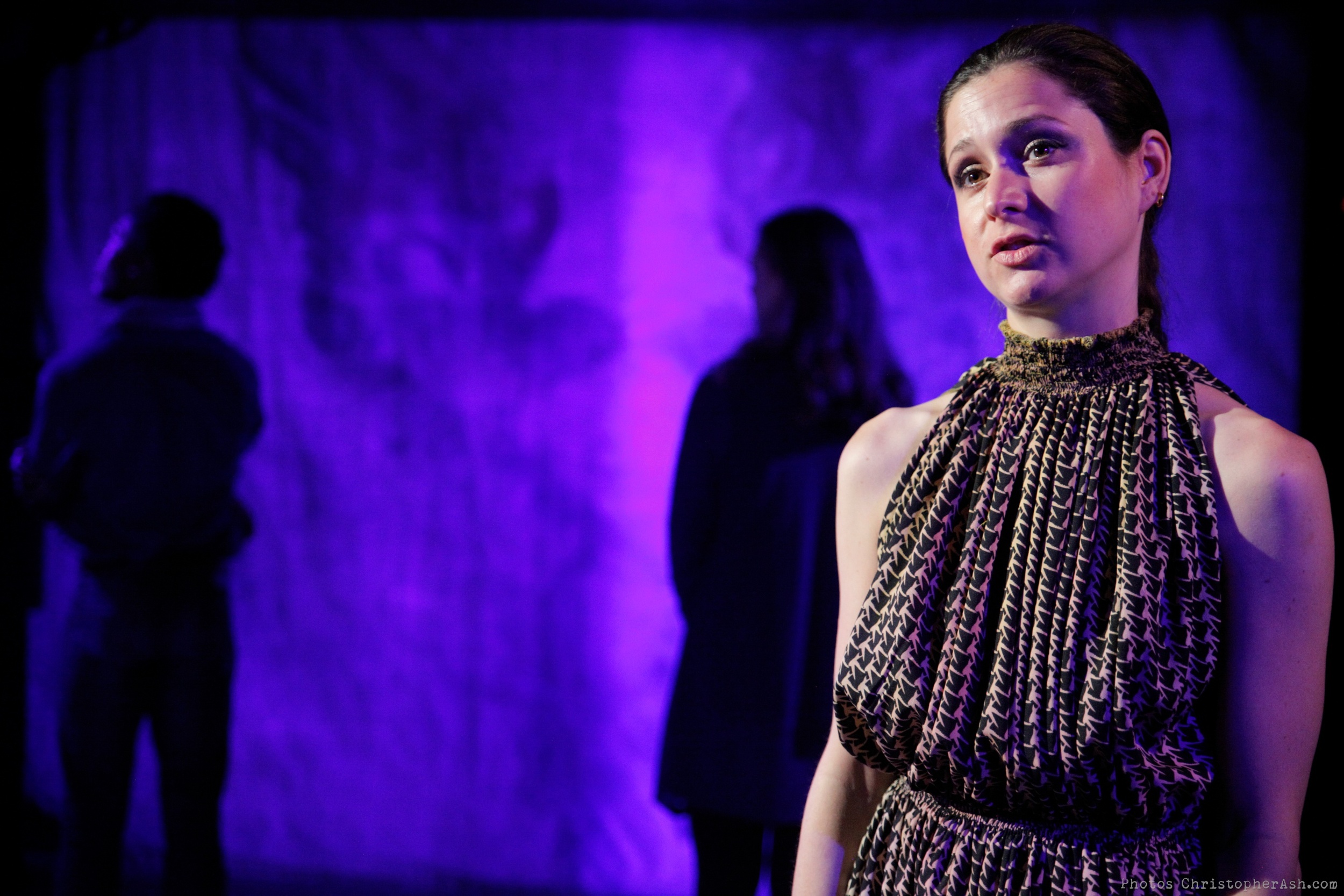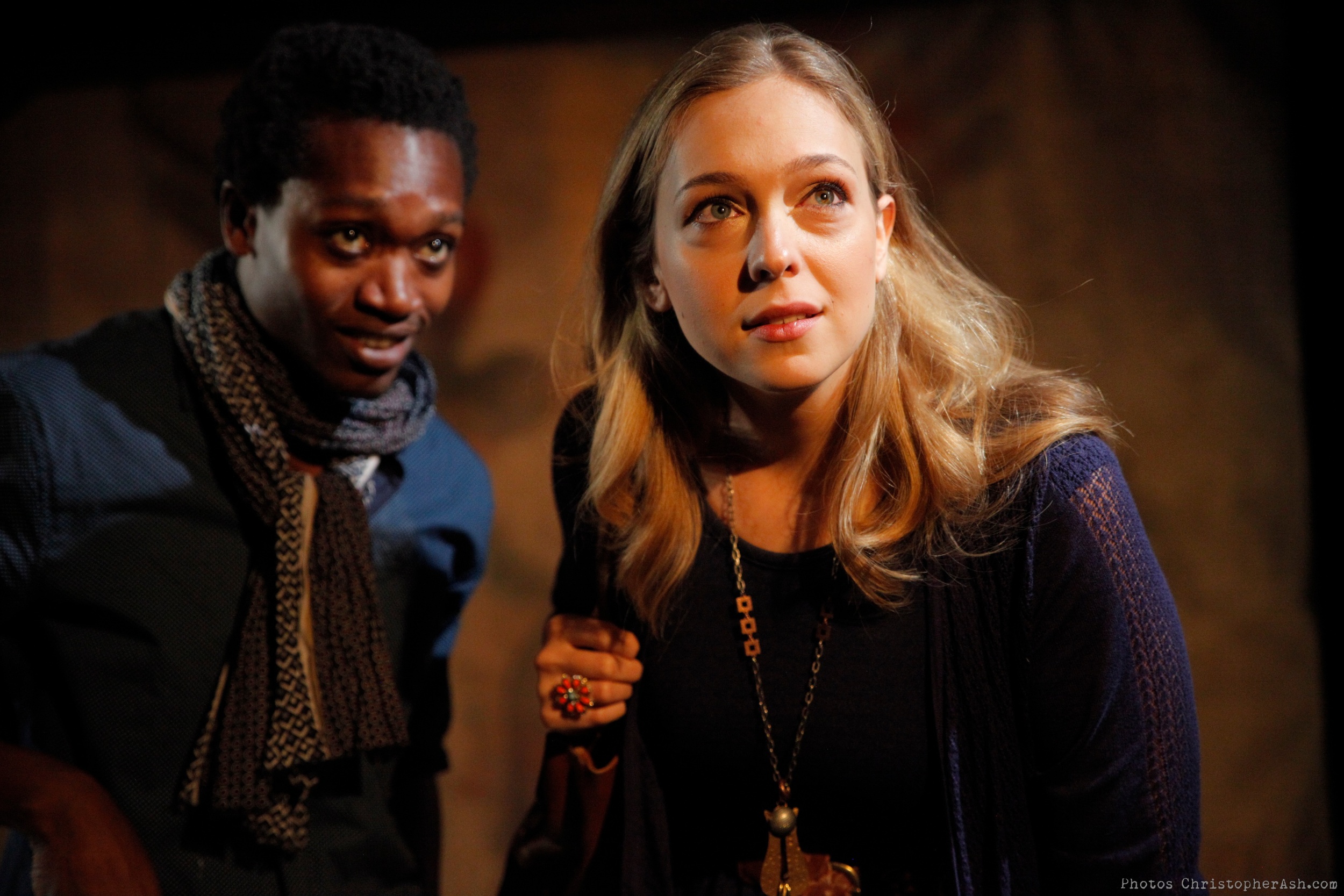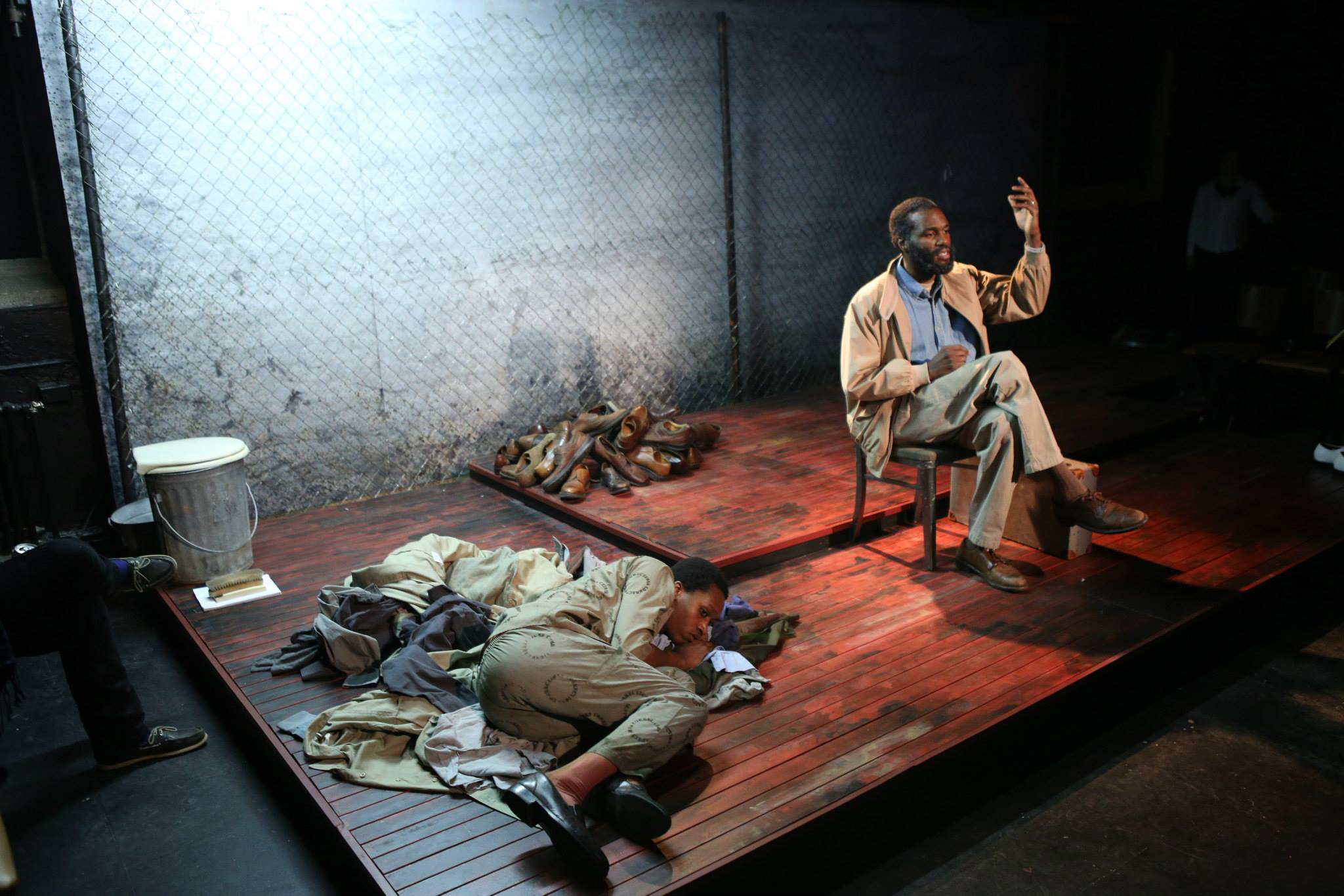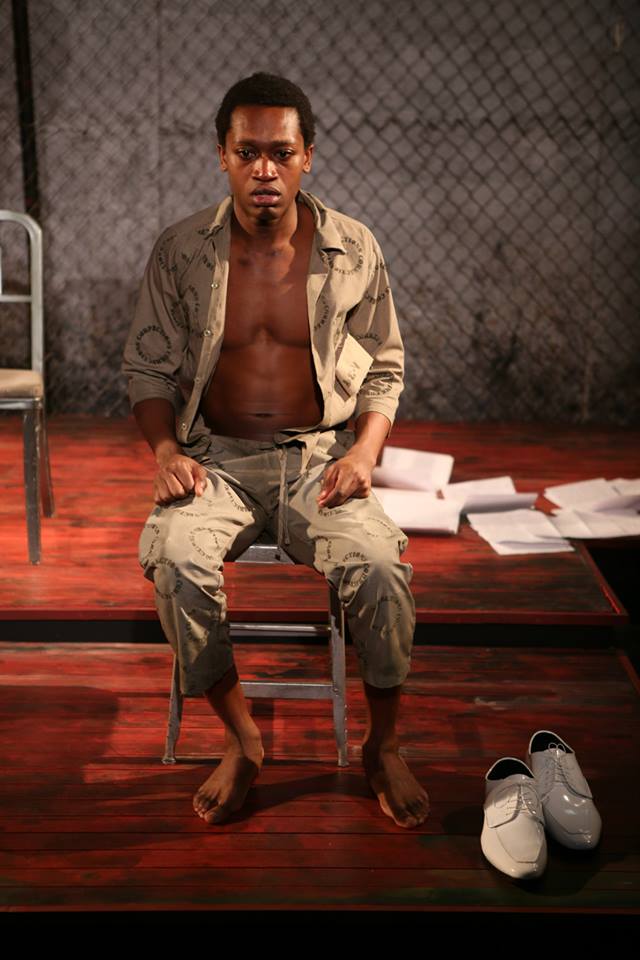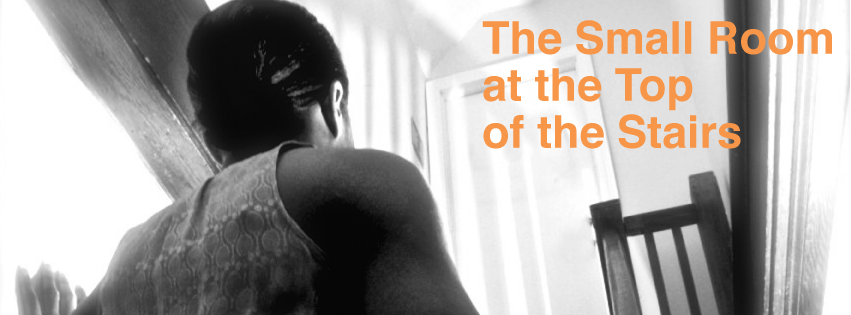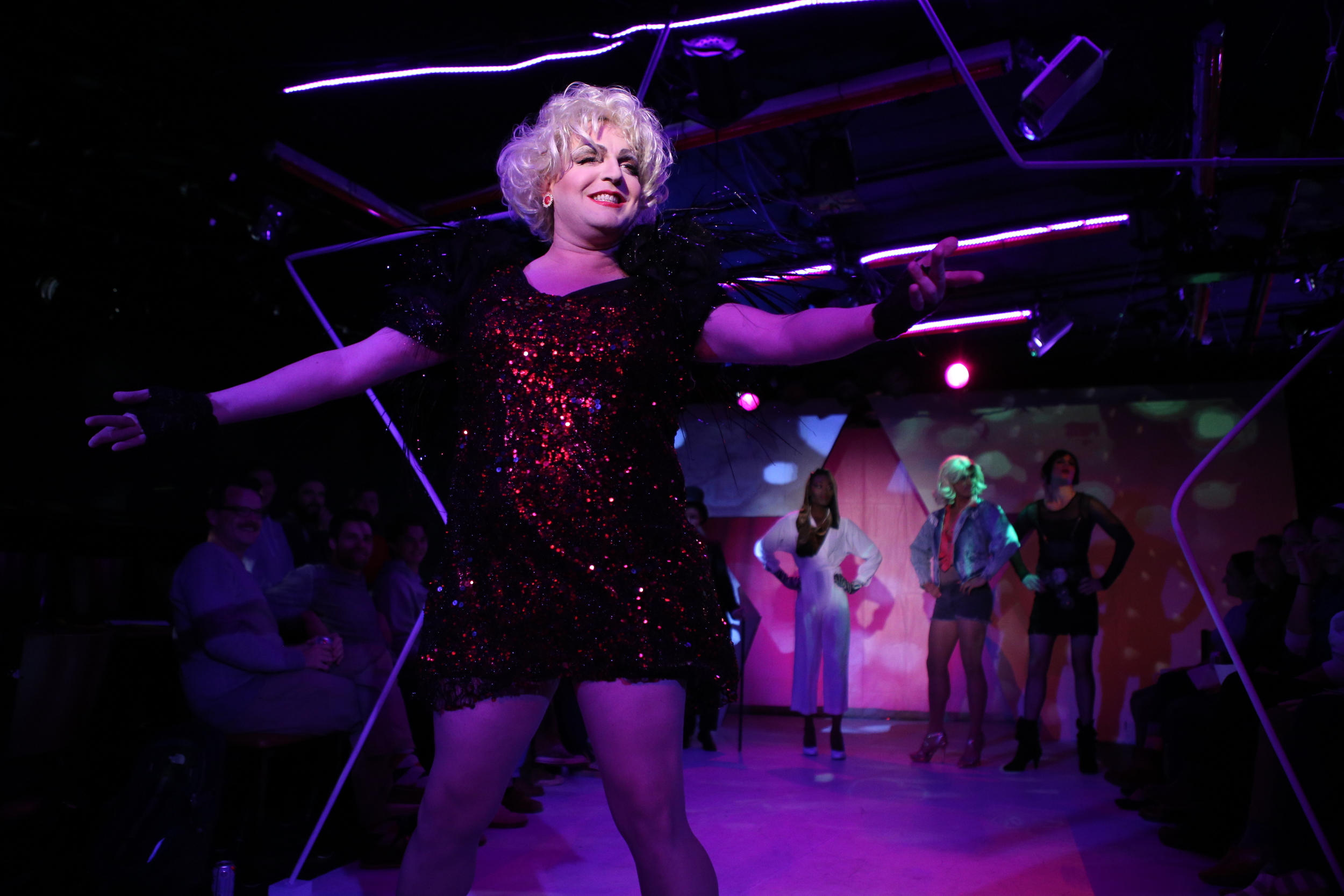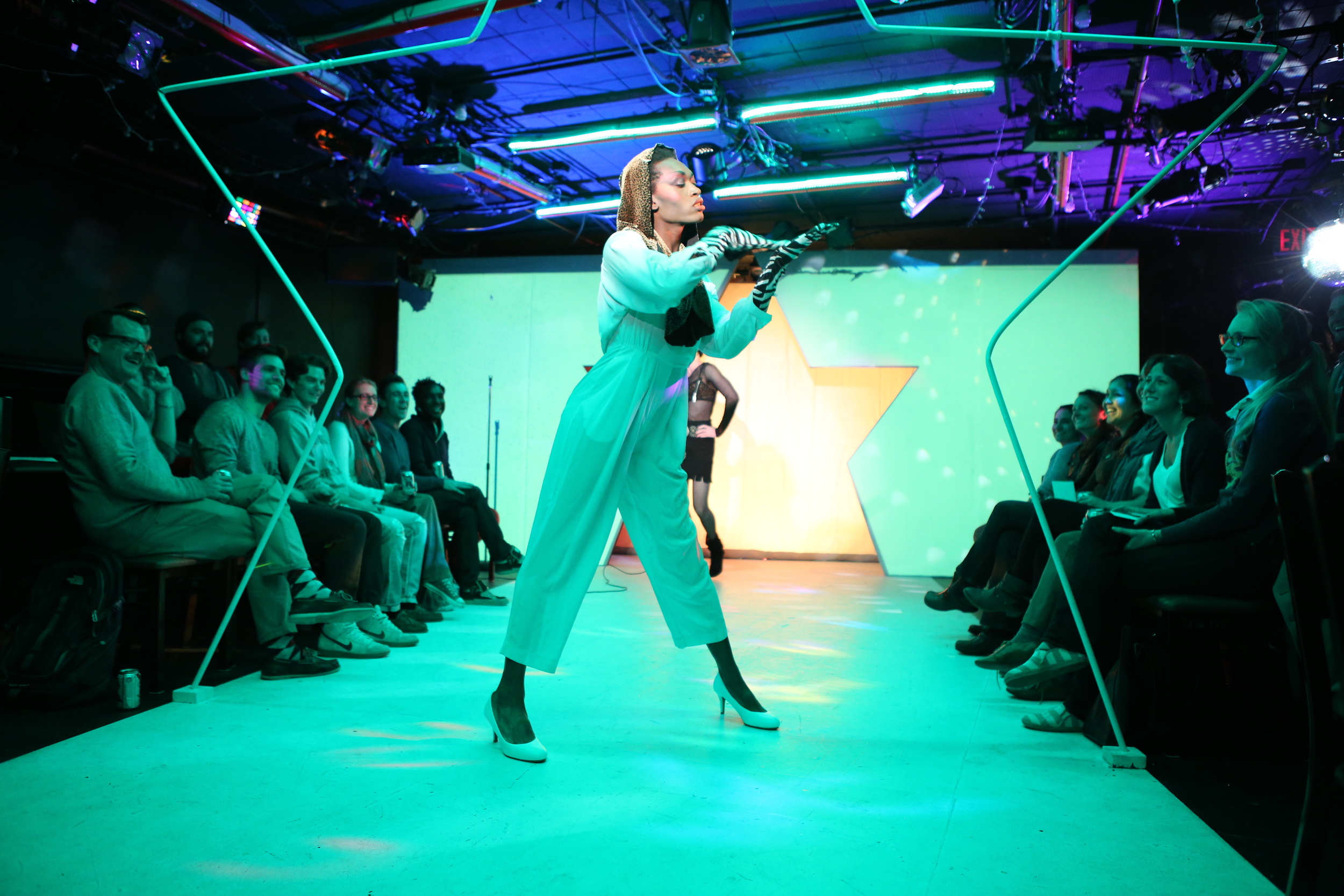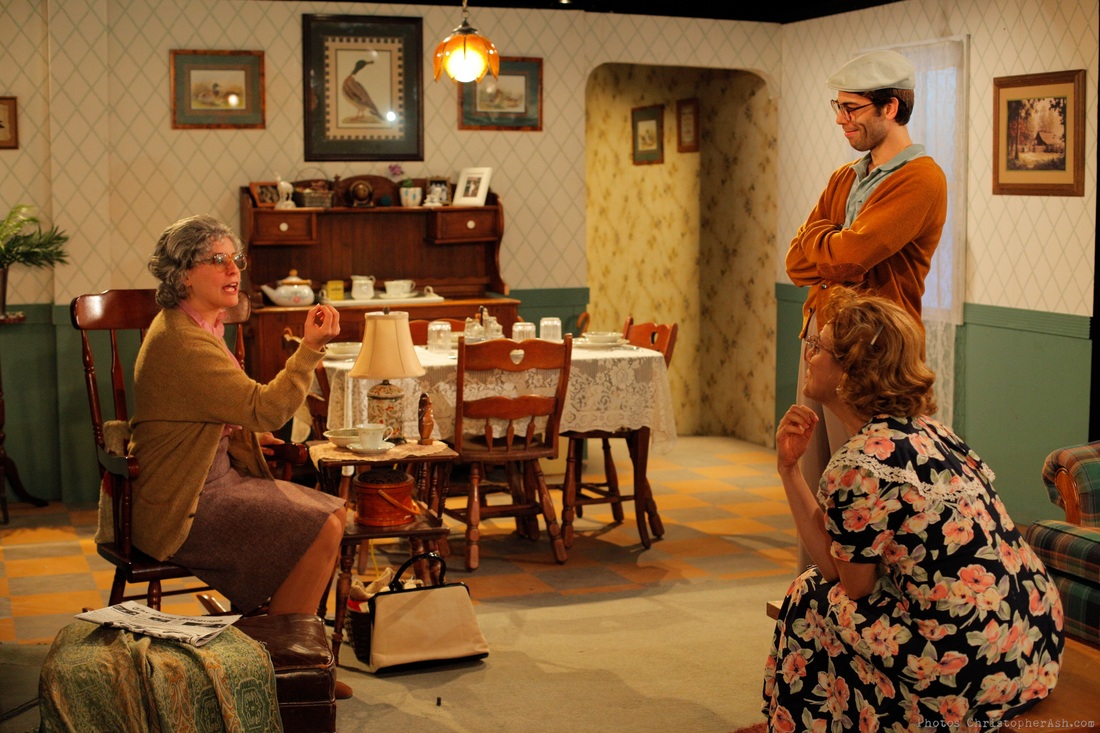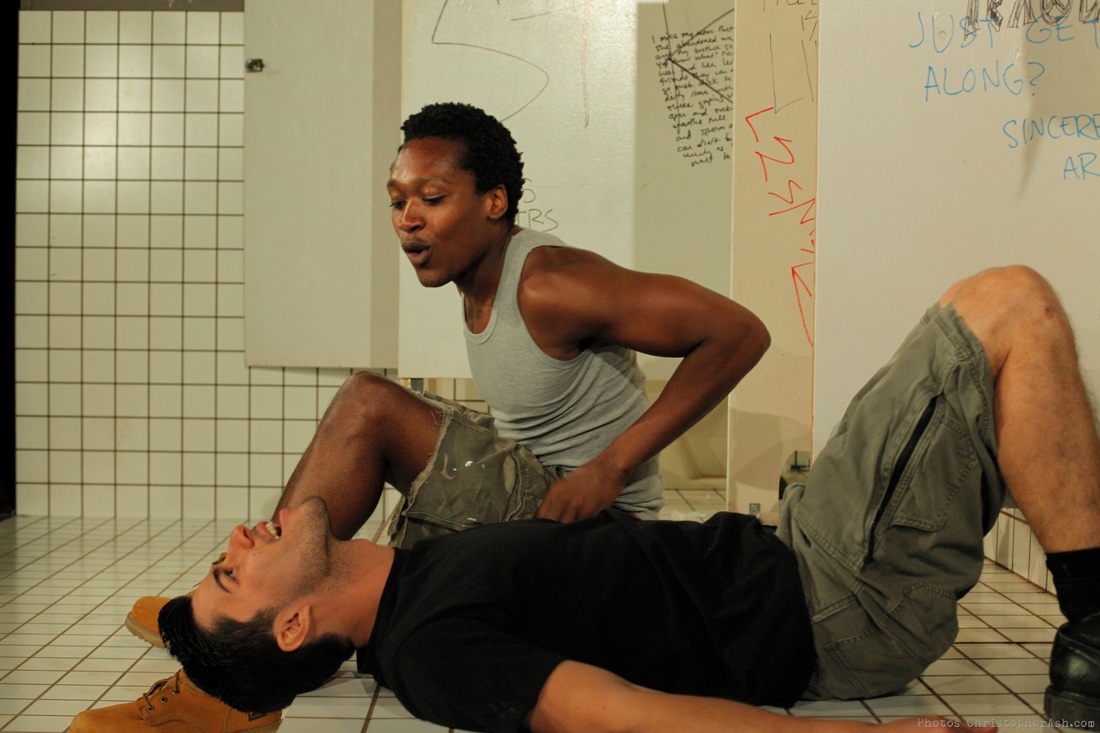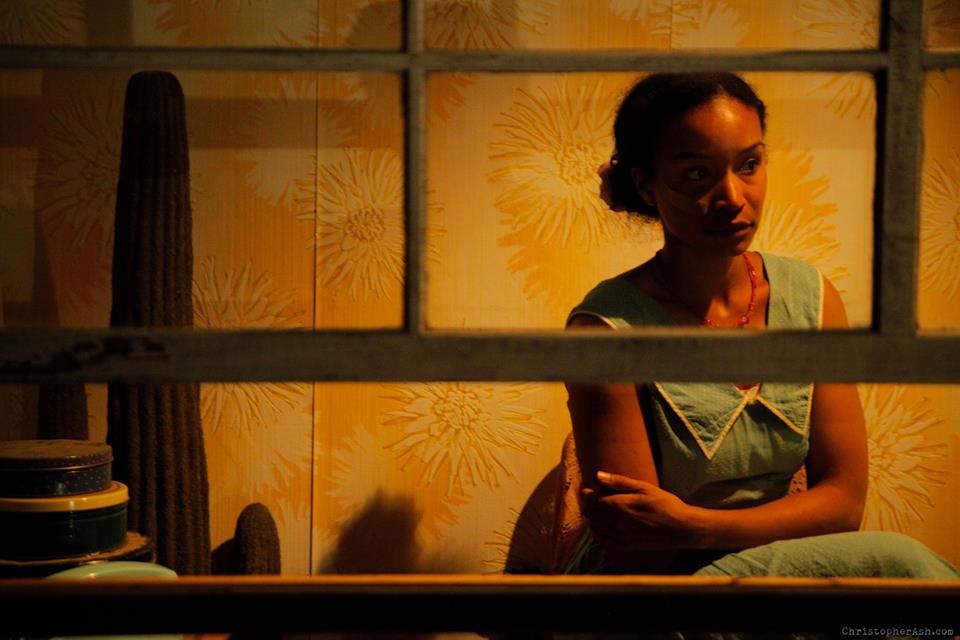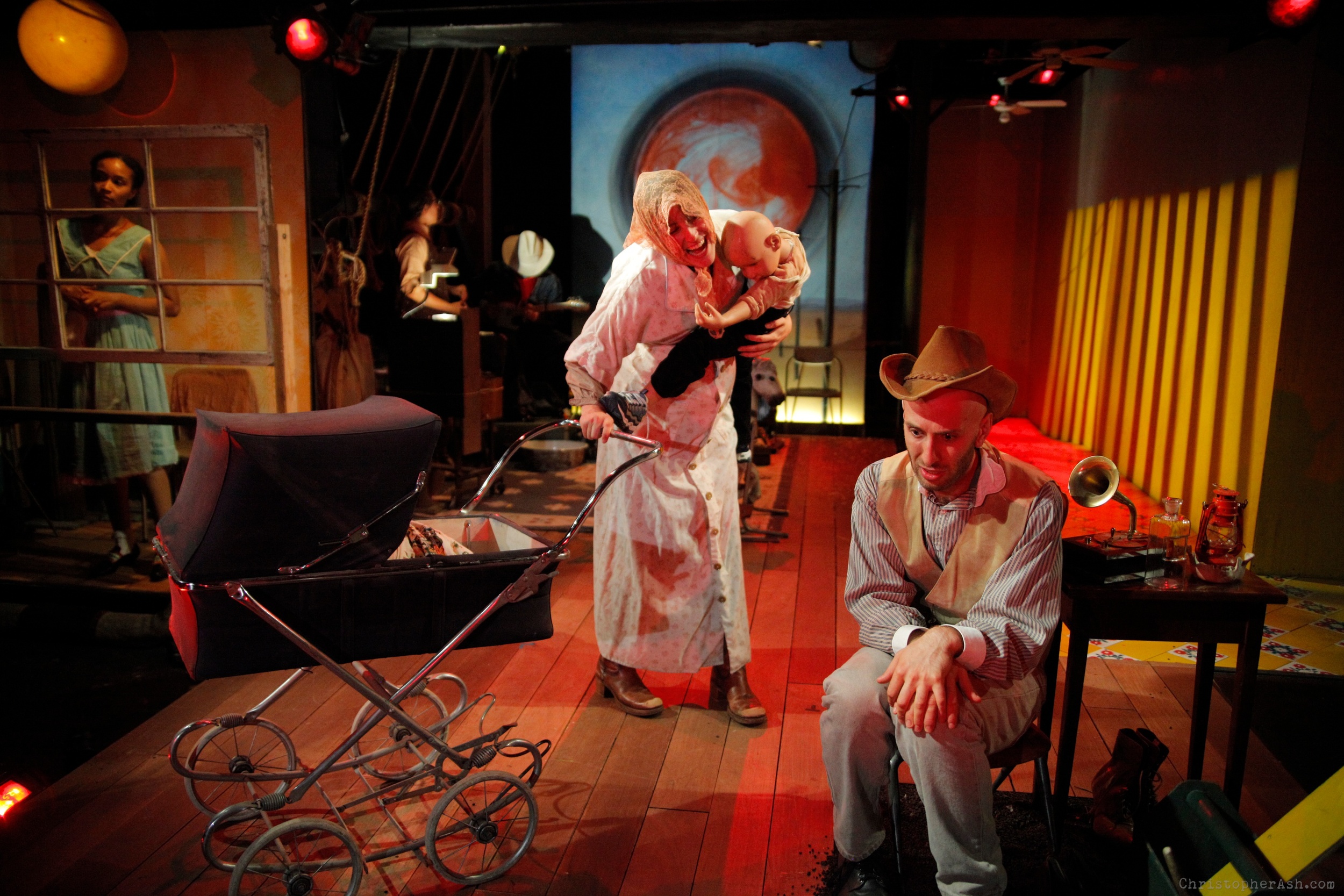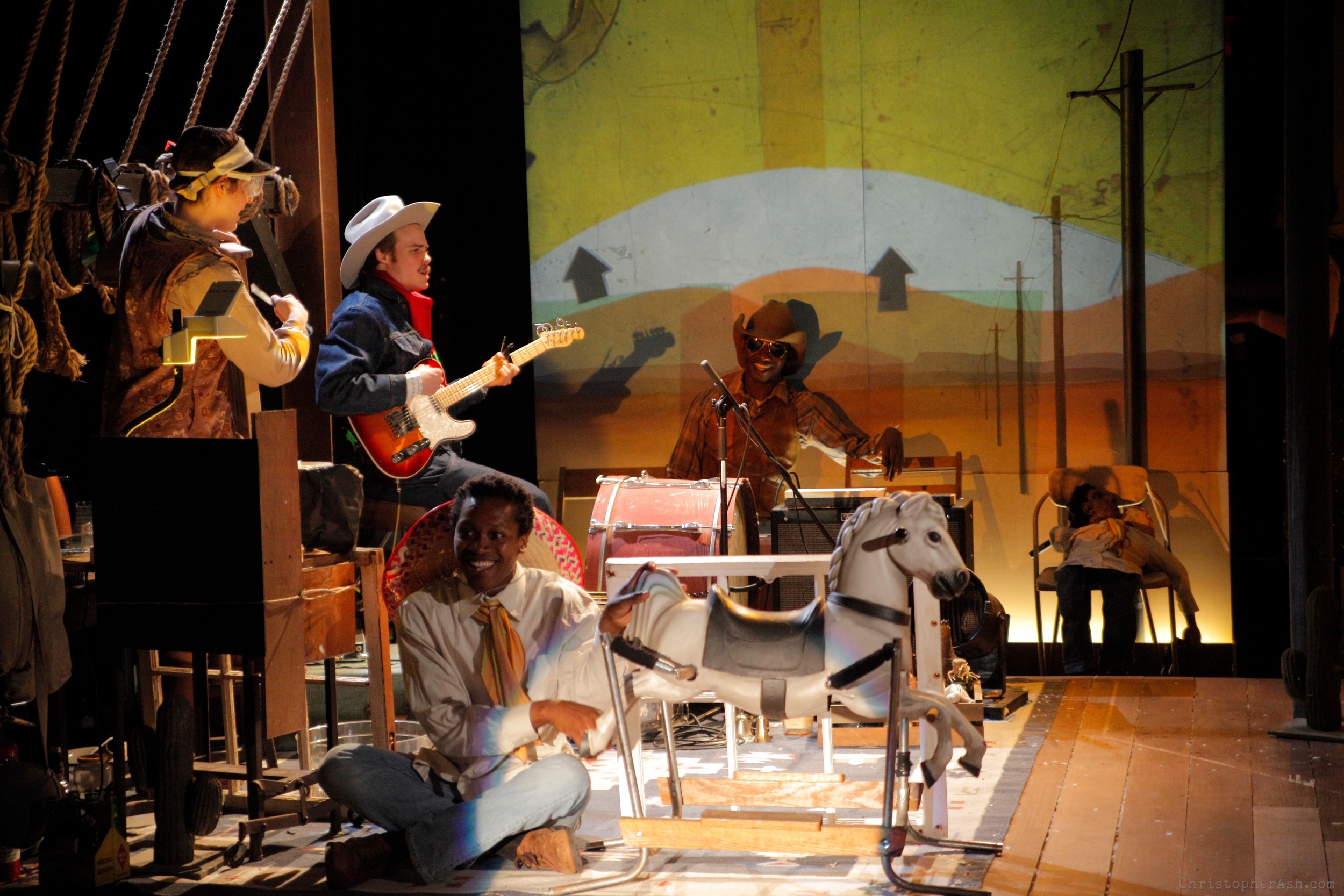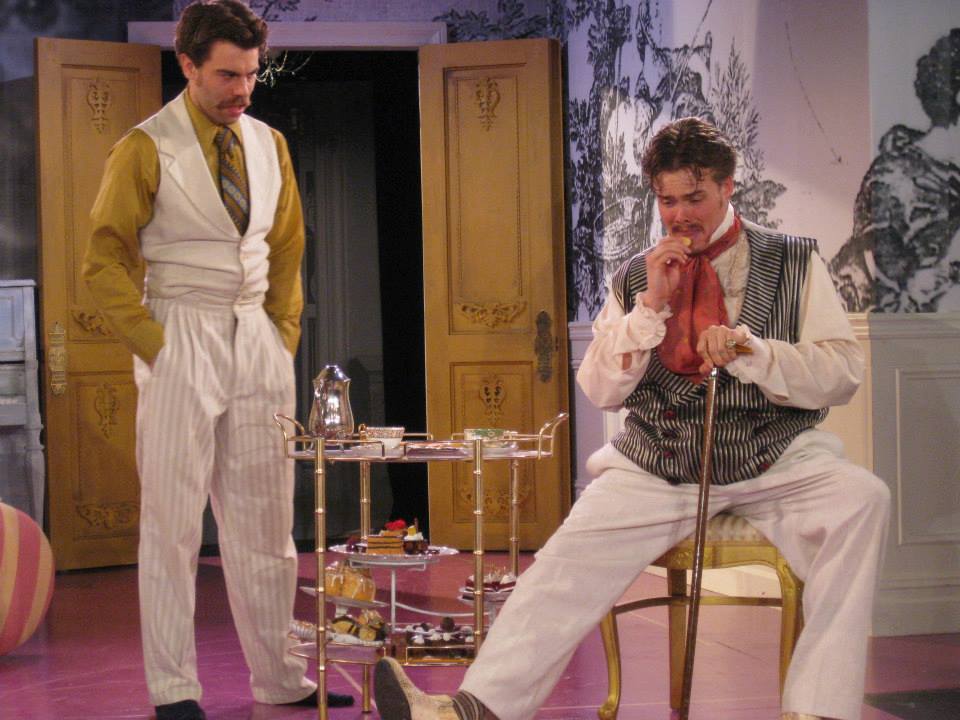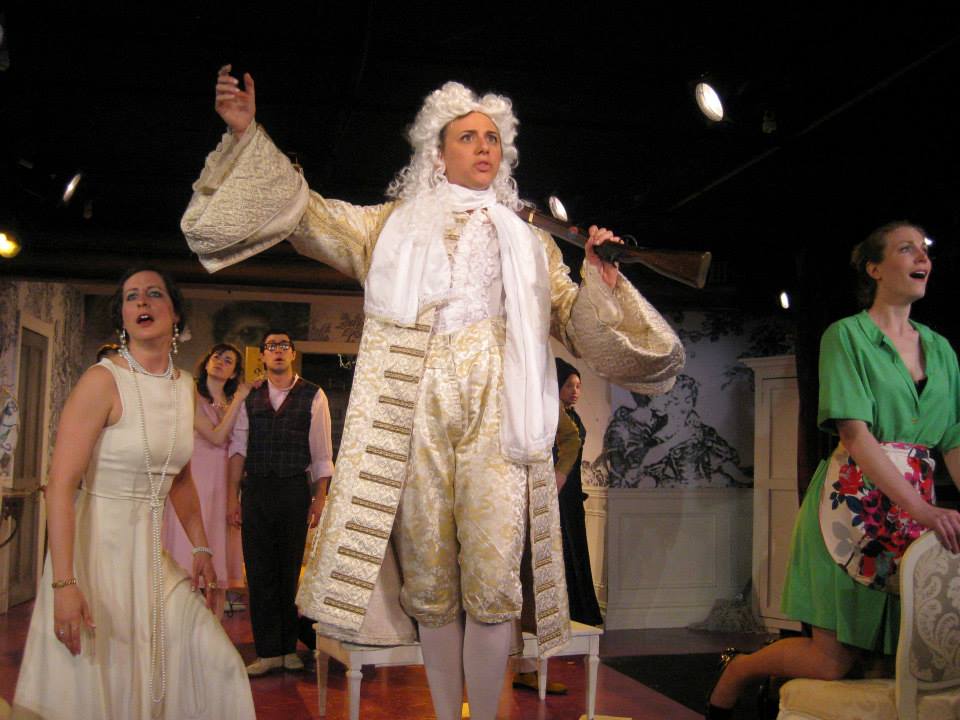Review of The Total Bent, The Public Theater
I happened to see The Total Bent, the energetic musical playing for a final extended week at The Public Theater, on Father’s Day. It was fitting, in a way. All over my facebook feed were fond tributes to great dads. Rarely did one hear a breath about the overbearing father, the belittler, the bully, or of the agon with one’s parental generation that, once upon a time, was de rigueur for any coming-of-age spirit, artists especially.
The Total Bent, text by Stew, music by Stew and Heidi Rodewald, directed by Joanna Settle, keeps alive the generational struggle. The stakes are high because Joe Roy (Vondie Curtis Hall) is a charismatic gospel star who relies upon his talented son, Marty (Ato Blankson-Wood), to provide him with lyrics and melodies he can use to get his message across. When we meet them—during the bus boycotts in Alabama (here the town is “Bluntgomery”)—Marty is dissatisfied with his role. Dad is too square to embrace the Civil Rights movement the son is hot to address. The funny, and catchy, song that delivers Roy’s critical take on the protest movement exhorts blacks gladly to take seats in the back of the bus. His view of black distinction, he feels, will be lost by becoming just like whites.
Joe Roy (Vondie Curtis Hall) (photo: Joan Marcus)
The racial themes in the play would be enough to make this an interesting show—particularly as Stew is quite adept at registering what the older generation feared about “equal rights,” and Curtis Hall is expert at getting across the smug high-mindedness of the preachers who told Martin Luther King, Jr., he should “wait.” But Stew has even more on his mind, and that can make for some fairly symbolic axes to grind: in particular, the problem of gospel music’s credo of an afterlife with a benign God who will soothe the racist indignities—and the lynchings and beatings and police actions—with heavenly balm. As one of Marty’s songs pertinently asks: “Why should black people, of all people, still believe in God?”
At the heart of this musical is a struggle that Stew conceives of in mythopoeic terms: the Father vs. the Son for the Holy Ghost. Joe Roy, who seems to have God on his side, is the patriarchal and paternalistic form of religion. He goes so far as to bless slavery for having brought Christ to blacks. It’s a view that infuriates Marty, but Joe’s line is not a self-serving come-on from a snake oil salesman. Curtis Hall’s portrayal is remarkably subtle in giving us both the willful coddler of the uneducated masses, and a sincere man who wants to promote the “turn the other cheek” humility that, Marty’s generation feels, goes cheek by jowl with oppression.
Early on, we see that Marty has his own path to follow, and Stew is at some pains to give his trajectory enough coherence for the theater-going audience. The show feels like a concept album on stage in the way that songs, more than story, control our access to what is happening. Unlike most musicals, the songs don’t simply replace speeches for characters: the songs are thematic expressions.
Abee (Curtis Wiley), Marty (Ato Blankson-Wood), Andrew (Jahi Kearse) (photo: Joan Marcus)
Key to the power of the concept’s enactment is the unflinching talent of Ato Blankson-Wood as Marty. Each time we think he’s finally pulling out all the stops to deliver Marty’s latest take on what the times demand of a black musical artist, Blankson-Wood goes yet further. The transformation is breath-taking. We see Marty go from a cynical assistant of his preening father to a driven, hungry, angry, sexy, and super bad musical artist in his own right. The music and costuming (Gabriel Berry) and hair (Cookie Jordan) put Blankson-Wood through some serious changes, and it’s great fun trying to catch all the cats he conjures up—Wilson Pickett, James Brown, Sly Stone, Lou Rawls, and, of course, Michael. At times, Marty seems to be courting the intricacy of the studio geniuses—the way Stevie Wonder met the challenges of The Beatles—while at other times he ignites a performative frenzy that his old man can only aspire to. Stew and Rodewald’s imaginative score takes gospel to places it ain’t been before.
Marty (Ato Blankson-Wood) and back-up singers (photo: Joan Marcus)
And the songs, as they both comment on Marty’s progress and express his condition, become engaged with the spiritual struggle at the heart of Stew’s vision of black music: the force of gospel, as an affirmation of the beauty and worth of suffering, vs. the great need to find a way to voice political and social and racial dissent. Marty’s ideal—which may be Stew’s, though it would be wrong to see Marty as his spokesman—seems to be a religious bond with the suffering black body, as Marty urges his listeners to drink his blood and eat his body, not as a delusion of himself as Christ but as a radical vision of blacks as Christ.
While this might sound incredibly heavy, it should be said that the show lets the music do the talking, and the band—led by Music Director Marty Beller on drums, with Stew on guitar and keyboard, and Rodewald on bass—is great, the songs pithy and impassioned, and the dialogue, which sometimes rhymes, only quasi-naturalistic. An added element, for entertainment’s sake, is the character of the British producer, Byron Blackwell (beaky David Cale, looking a bit like the aged Keith Richards), a lover of blues and authentic R&B, who has to choose between father—a blues legend before he went gospel—and the son, an up-and-coming genius. Cale delivers a few comic songs with a touch of Anthony Newleyesque showmanship to keep us apprised of the fact that—whichever Roy God is speaking through—show-biz is this man’s idol.
Marty (Ato Blankson-Wood), center, Byron Blackwell (David Cale), foreground (photo: Joan Marcus)
There are no female parts in the play and the conceit of Marty’s mother Mary—Joe Roy thinks of her as a saint, Marty as a Magdalen—drifts into oedipal cliché, but needn’t. If the show goes forward, it could do with a flashback or two to let Mom add her pipes to the proceedings, letting us see how much those two views of femininity—the gospel choir and the street-corner mamas—fed the life’s blood of the musical journey Stew and Rodewald’s lively and inventive show takes us on.
Andrew Lieberman’s scenic design gives us a homey recording studio that transforms swiftly into a concert venue with catwalk. Some scenes, like a visit to the dark studio by awed Abee (Curtis Wiley) and Andrew (Jahi Kearse) (think Amos and Andy) don’t make much narrative sense, and sometimes we flip a bit quickly in period, but the songs make it all work. Not to be missed for the performances by Curtis Hall and Blankson-Wood, The Total Bent is totally mind-bending in its ambitions and delivery.
The Total Bent
Text by Stew
Music by Stew and Heidi Rodewald
Directed by Joanna Settle
Scenic Design: Andrew Lieberman; Costume Design: Gabriel Berry; Lighting Design: Thom Weaver; Sound Design: Obadiah Eaves and Sten Severson; Hair and Wig Design: Cookie Jordan; Music Director: Marty Beller; Music Contractor: Dean Sharenow; Choreography: David Neumann; Production Stage Manager: Chris DeCamillis; Stage Manager: Elizabeth Ann Goodman; Dance Captain: Curtis Wiley
Cast: Ato Blankson-Wood; Kenny Brawner; David Cale; Vondie Curtis Hall; Damian Lemar Hudson; Jahi Kearse; Curtis Wiley
Musicians: Marty Beller, drums; John Blevins, trumpet; Kenny Brawner, organ, keyboard; Damian Lemar Hudson, keyboards, guitar, harmonica; Brad Mulholland, woodwinds; Heidi Rodewald, bass, keyboard; Stew, guitar, piano.
The Public Theater
425 Lafayette Street
New York, NY
May 10-June 26, 2016







